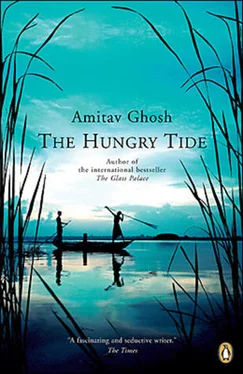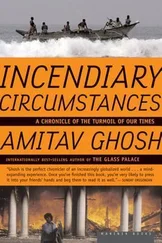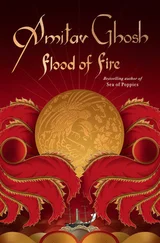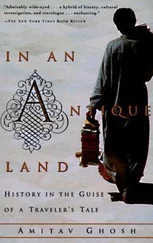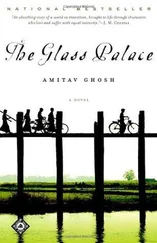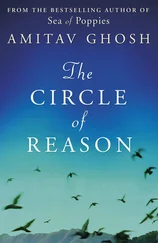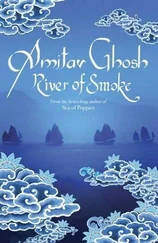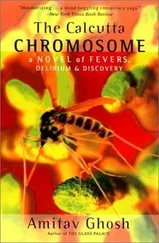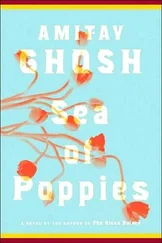Meanwhile, Fokir had dropped to his haunches and seized a pair of oars. The current had already carried the boat several hundred feet from the creek where the dolphins had been foraging. Now Fokir began to heave at the oars, turning the boat from one creek into another, laboring to lengthen the distance.
After some twenty minutes of furious rowing they came to an inlet that curved deep into the interior of a thickly forested island. Fokir kept the boat moving until they reached a spot where the boat was well sheltered from the currents of the main channel. Here, after dropping anchor, he tore off his drenched T-shirt and reached for a gamchha to wipe away the sweat that was pouring down his chest.
After he had caught his breath, he glanced at Piya and said, “Lusibari?”
Piya was only too glad to assent. “Yes,” she said. “Let’s head for Lusibari. It’s time.”
Part Two. The Flood: Jowar
I had thought that on the way to Lusibari my face would lose the flush it had acquired in Morichjhãpi: the brisk air of the river would cool my skin and the rocking of Horen’s boat would slow the pace of my heart. But no, exactly the opposite happened: with every turn a new vista seemed to open in front of me. I could not keep still. I put away my umbrella and stood up, opening my arms as if to embrace the wind. My dhoti became a sail and I a mast, tugging the boat toward the horizon.
“S aar,” cried Horen, “sit down! The boat will roll over — you’ll fall.”
“Horen, you are the best of boatmen. You’ll find a way of keeping us afloat.”
“Saar,” said Horen, “what’s the matter with you today? You don’t seem like your old self.”
“You are right, Horen. I am not my old self anymore. And it’s you who’s responsible.”
“And how’s that, Saar?”
“Wasn’t it you who took me to Morichjhãpi?”
“No, Saar. It was the storm.”
Forever modest, our Horen. “All right, then. It was the storm.” I laughed. “It was the storm that showed me that a man can be transformed even in retirement, that he can begin again.”
“Begin what, Saar?”
“Begin a new life, Horen, a new life. The next time we come to Morichjhãpi my students will be waiting. I’ll teach as I have never taught before.”
“And what will you teach them, Saar? What will the lesson be?”
“Why, I’ll tell them about —”
And what indeed was I to tell them about? Expert boatman that he was, Horen had found a way of spilling the wind from my sails.
I sat down. This was a matter that needed careful thought.
I would start, I decided, with magical tales of the kind to which these children were accustomed. “Tell me, children,” I would begin, “what do our old myths have in common with geology?”
This would catch their interest. Their eyes would narrow, they would puzzle over my question for a minute or two before giving up.
“Tell us, Saar.”
“Goddesses, children,” I would announce in triumph. “Don’t you see? Goddesses are what they have in common.”
They would look at each other and whisper, “Is he teasing? Is this a joke?” Presently a small, hesitant voice would speak up: “But Saar, what do you mean?”
“Think about it,” I would say, “and you’ll see. It’s not just the goddesses — there’s a lot more in common between myth and geology. Look at the size of their heroes, how immense they are — heavenly deities on the one hand, and on the other the titanic stirrings of the earth itself — both equally otherworldly, equally remote from us. Then there is the way in which the plots go round and round in both kinds of story, so that every episode is both a beginning and an end and every outcome leads to others. And then, of course, there is the scale of time — yugas and epochs, Kaliyuga and the Quaternary. And yet — mind this! — in both, these vast durations are telescoped in such a way as to permit the telling of a story.”
“How, Saar, how? Tell us one of these stories.”
And so I would begin.
Maybe I would start with the story of Vishnu, in his incarnation as a divine dwarf, measuring out the universe in three giant strides. I would tell them about the god’s misstep and how an errant toenail on one of his feet created a tiny scratch on the fabric of creation. It was this pore, I’d tell them, that became the source of the immortal and eternal Ganga that flows through the heavens, washing away the sins of the universe — this was the stream that would become the greatest of all the earth’s rivers.
“The Ganga? Greatest of all rivers?” They would rise, provoked beyond endurance by my mischievous phrasings. “But Saar, many rivers are longer than our Ganga: the Nile, the Amazon, the Mississippi, the Yangtze.”
And then I would produce my secret treasure, a present sent to me by a former student — a map of the sea floor made by geologists. In the reversed relief of this map they would see with their own eyes that the Ganga does not come to an end after it flows into the Bay of Bengal. It joins with the Brahmaputra in scouring a long, clearly marked channel along the floor of the bay. The map would reveal to them what is otherwise hidden underwater: and this is that the course of this underwater river exceeds by far the length of the river’s overland channel.
“Look, comrades, look,” I would say. “This map shows that in geology, as in myth, there is a visible Ganga and a hidden Ganga: one flows on land and one beneath the water. Put them together and you have what is by far the greatest of the earth’s rivers.”
And, to follow this, I decided, I’d tell them the story of the Greek goddess who was the Ganga’s mother. I would take them back to the deep, deep time of geology and I would show them that where the Ganga now runs there was once a coastline — a shore that marked the southern extremity of the Asian landmass. India was far, far away then, in another hemisphere. It was attached to Australia and Antarctica. I would show them the sea and tell them about its name, Tethys, in Greek mythology the wife of Oceanus. There were no Himalayas then and no holy rivers, no Jamuna, no Ganga, no Saraswati, no Brahmaputra. And since there were no rivers, there was also no delta, no floodplain, no silting, no mangroves — no Bengal, in other words. The green coastline of Tamil Nadu and Andhra Pradesh was then a frozen waste with ice running to a depth of two hundred feet. Where the southern shore of the Ganga now lies was a length of frozen beach that dipped gently into the waters of the now vanished Tethys Sea.
I would show them how it happened that India broke away 140 million years ago and began its journey north from Antarctica. They would see how their subcontinent had moved, at a speed no other landmass had ever attained before; they would see how its weight forced the rise of the Himalayas; they would see the Ganga emerging as a brook on a rising hill. In front of their eyes they would see how, as India traveled, the Tethys shrank, how she grew thinner and thinner as the channel closed. They would watch as she withered, the two landmasses finally colliding at the expense of the mother ocean; they would see her dying but they would shed no tears, for they would see also the birth of the two rivers in which her memory would be preserved, her twin children — the Indus and the Ganga.
“And do you know how you can tell that the Sindhu and the Ganga were once conjoined?”
Читать дальше
Конец ознакомительного отрывка
Купить книгу
